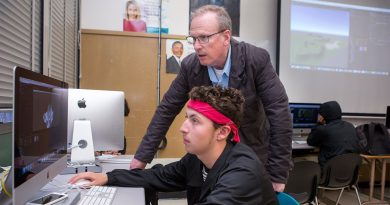How Math and English Teachers Encourage Civic Engagement
There are appealing, thought-provoking opportunities outside of social studies for teaching students how to be involved citizens.
Is high school civics class the only place where your students build the skills and knowledge to become engaged, informed citizens? If so, they’re missing rich and relevant learning opportunities in other content areas.
In math, students can investigate the geometry of gerrymandering or analyze the accuracy of graphs of vaccination rates. In English, literature study can help them understand perspectives different from their own and navigate difficult conversations about social issues. Interdisciplinary projects can inspire them to create multimedia stories that put a human face on statistics.
These are just a few examples shared by six secondary teachers—three from English, three from math—who spent many hours this past spring brainstorming how to infuse civic engagement into their content areas. Two university researchers and I rounded out the project team. The outcome is a new resource, Quantitative Civic Reasoning: A Guide for Centering Civic Innovation in Math and English Language Arts Classrooms, with practical strategies to build students’ identity and agency as citizens.
Focus on Core Components
Although the responsibility for civic education is often relegated to social studies, “English and math should be driving conversations on civics,” argues project co-leader Antero Garcia, associate professor of education at Stanford University. Given the well-documented decline in time devoted to civics over the past two decades, it’s a compelling argument.
Focusing on civic issues doesn’t take away from the content goals of math or English. Instead, according to co-leader Emma Gargroetzi, postdoctoral Fellow of STEM Education and assistant professor of instruction at the University of Texas at Austin, mathematical practices and literary practices “both contribute to and are deeply fundamental to civic learning.”
Gargroetzi and Garcia have identified core components that amplify youth civic engagement, including student choice, research, and classroom discourse. In practice, teachers integrate these components to varying degrees in lessons, norms, routines, and longer-term projects. That means a wide range of entry points for teachers who want to take a more active role in their students’ civic learning.
Classroom Culture
The classroom is a place to develop and practice the habits of civic participation. Cocreating community with students ensures that everyone has a voice, the space to explore challenging topics, and tools to navigate controversies and build consensus. In math, that might be a protocol for collaborative problem-solving and examining the power dynamics of the classroom. In English, teachers can use techniques such as Socratic seminars, restorative circles, and Harkness discussions to engage everyone in conversation.
Students can join their peers in a seminar discussion about sources that represent viewpoints different from their own, an activity that one teacher describes as “getting out of the echo chamber.” Gina Wei, a high school math teacher from Philadelphia, says that some of the ways “we practice citizenship in the classroom” are through discussion structures, group work norms, and the ways that students participate.
Kia Turner, who taught middle school English in Harlem before pursuing a PhD at the Stanford Graduate School of Education, says the classroom “doesn’t stop at English content. How do I give my students the tools to not only navigate society as it is but also to eventually transform that society? What do students need to know to engage in civic conversations? English supports a lot of this.”
Relevant Context
Math teacher Xi “CiCi” Yu describes the news as full of “mathematical dilemmas,” from the rates of Covid infections among different populations to the incidence of racial profiling by police. Gina Wei plans units and lessons “that give students opportunities to use their mathematical skills to interrogate and learn more about the problems that they see in their communities and the problems that they face, and also come up with solutions and take actions.”
English teacher Samantha Diego creates space for her ninth-grade students in South Los Angeles to “actively talk about what’s affecting our community in particular. Not everyone’s going to agree. And that’s OK. This is what learning looks like. This is what democracy looks like.”
Authentic Audience
Connecting with an audience beyond the classroom is core to civic learning. Math and English teachers give students a platform for sharing their civic perspectives via social media, at public events, or by having students present data to influence decision-makers.
With her ninth-grade English students, Texas teacher Janelle Bence facilitates an annual community project called Slamming for a Cause, in collaboration with AP Human Geography facilitator Danae Boyd and Digital Media facilitator Zachary Ruiz. Students choose social issues to research and then compose pieces that they polish with help from a professional poet. The culminating event—a well-attended poetry slam for which students compete to earn a coveted spot—is also a fundraiser for a community cause that students choose. “I want them to remember that they did difficult things, they spoke about difficult things, and they have the confidence to do that again,” Bence says.
Navigating Tensions
Teachers who embrace their role as civic educators acknowledge the tensions that can come with this work, especially at this polarized time. “When I was growing up, politics didn’t belong in the classroom,” recalls Kia Turner. “But to not say anything [about controversies] is a political choice, too.”
Ethan Weker, a 20-year math teaching veteran from California, used to think that his role was to focus just on “math, math, math.” Only recently has he come to recognize that his math classroom should be a place to explore and discuss current events and controversies through the lens of quantitative reasoning. “A lot of big questions can be investigated through math,” he says. “My desire for my students is that they see the world as a place with math in it. It can be a tool to understand and change the world, and a tool that they can wield.”
When civic education has a place in math and English class, students have more opportunities to build the skills they need to be well-informed citizens.
Source: https://www.edutopia.org/article/how-math-and-english-teachers-encourage-civic-engagement




